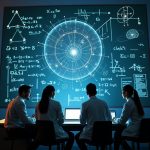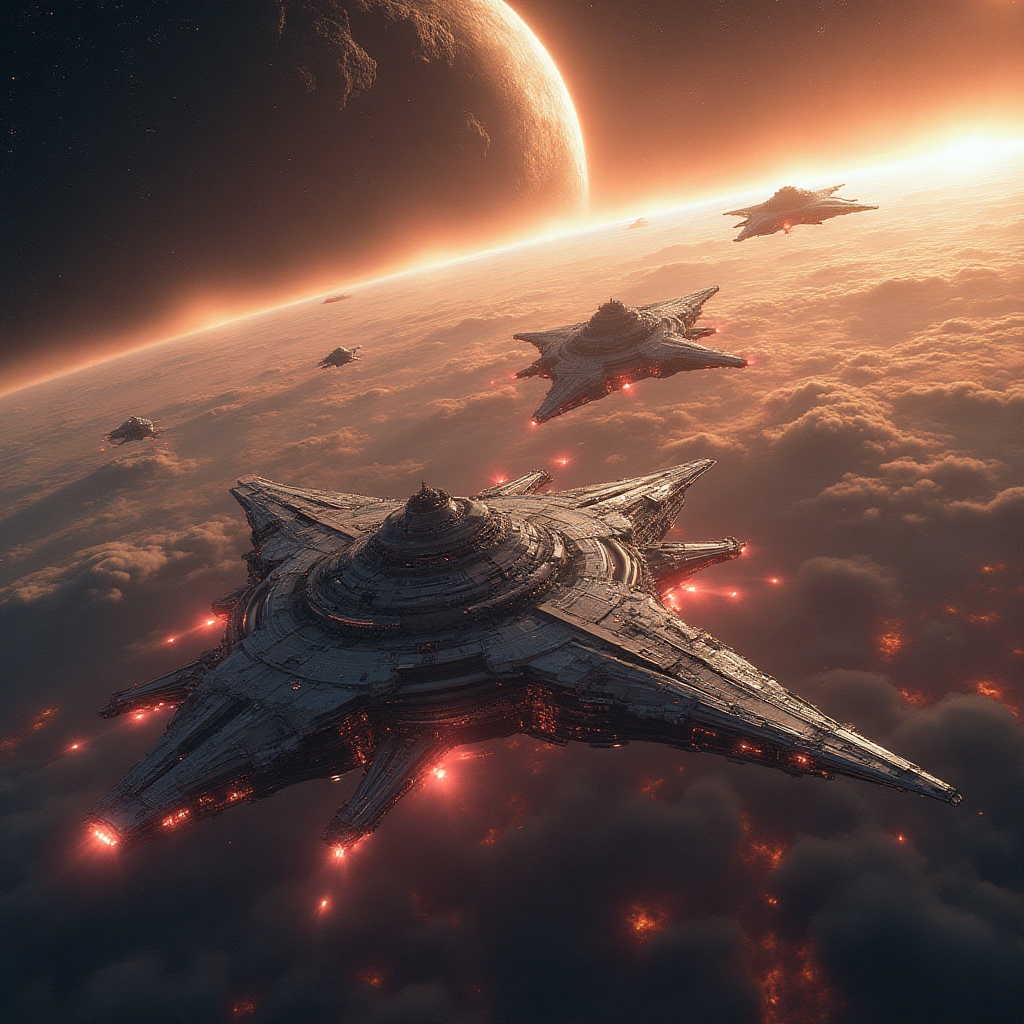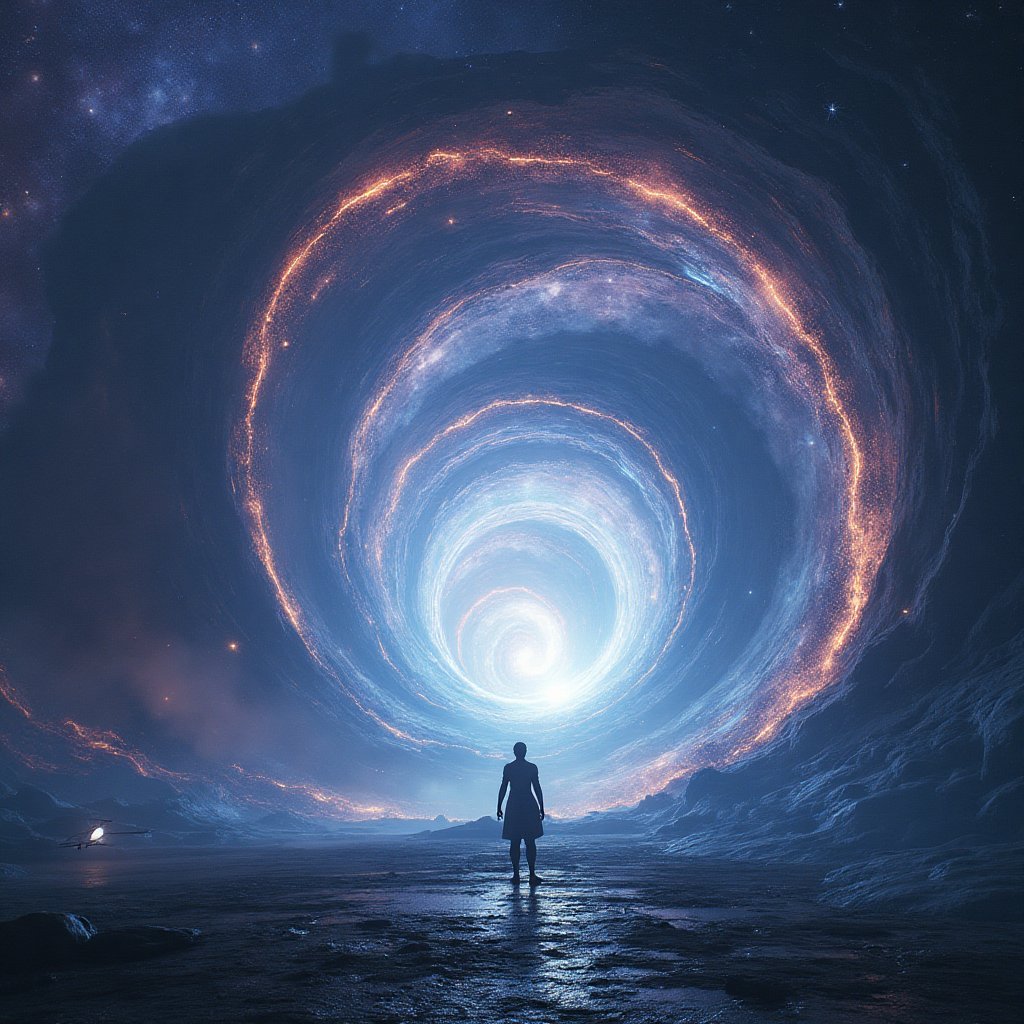Introduction: Quantum Computing and the New Frontier
The future belongs to those who believe in the beauty of their dreams. - Eleanor Roosevelt. In the grand scheme of the universe, our dreams are limitless—much like our abilities to uncover cosmic mysteries. Dreamers, like physicists and researchers, have always looked to the stars, wondering what lies beyond. Every new leap in technology, such as quantum computing and artificial intelligence (AI), enables us to explore these vast unknowns with greater depth and precision.
But here's the kicker: What if we’re standing on the edge of a technological evolution that could redefine our place in the universe? As captivating as a superhero squeezing the power of a black hole into a handheld device sounds, this is the promise of quantum-powered AI. Imagine decoding cosmic data faster than the speed of light! It's a reality that could change everything.
As Robert Oppenheimer once mused, “Now I am become Death, the destroyer of worlds,” we need to ask ourselves: could quantum computing be the creator of worlds instead? This article delves into the synergies between quantum computing and artificial intelligence, revealing how this coupling could change the field of space exploration forever.
1. The Quantum Leap: Understanding Quantum Computing
To grasp the true power that quantum computing holds, we need to unravel its complex yet fascinating principles. Unlike classical computers, which process information in binary (0s and 1s), quantum computers employ quantum bits, or qubits. Think of a qubit as a magical coin that can spin in the air: while it’s spinning, it’s both heads and tails at the same time. Sounds like a magic trick? Well, this phenomenon, known as superposition, allows quantum machines to perform multiple calculations simultaneously, making them light-years ahead of traditional methods.
1.1 Quantum Bits (Qubits): The Power of Superposition
A qubit isn’t just a simple 0 or 1; rather, it embodies potentiality. When qubits are in superposition, they can represent various combinations of both states. Imagine having a super-smart hamster that can run through a maze not just one way but exploring every single path at once! That’s the kind of speed and efficiency quantum computers bring to the table.
1.2 Entanglement: The Cosmic Connection
Now, enter the enchanting world of entanglement. This bizarre phenomenon happens when two qubits become linked, such that the state of one qubit is dependent on the state of the other, regardless of how far apart they are. It’s like having a pair of dancing partners on a cosmic dance floor—their moves are synchronized, no matter the distance! This connection allows for instantaneous data correlation, cutting down the time needed to analyze complex datasets, which is vital for exploring the universe.
2. Cosmological Data: The Challenge of Analysis
The universe is like that friend who can't stop talking about their vacation—there’s just so much to take in! From stunning telescope images that capture galaxies far away to intricate trails of cosmic particles dancing in the void, the amount of data generated is overwhelming. Traditional methods, like trying to juggle water balloons, just don't cut it. If we’re ever going to make sense of this cosmic chatter, we need innovative tools that match its volume.
2.1 Current Data Volume
Ever heard of "petabytes"? It sounds like a cute little puppy, but it's actually a unit of measurement for data. Astronomical surveys are generating petabytes of data every single day! To put this in perspective, one petabyte is enough to store the data equivalent of every single book ever written, more or less. This flood of information requires new and exciting ways to break down complex data into bite-sized, meaningful insights. Without proper analysis, valuable information remains locked away, like the secret ingredient in grandma's famous spaghetti sauce.
2.2 Human Limitations
While we humans are incredibly smart, our brains aren’t exactly built for speed. Think of it this way: if analyzing cosmic data were a race, we would be leisurely strolling around the track while the universe zooms ahead like a rocket ship. Unlike computers, we can’t process vast amounts of information quickly enough to keep up. This mismatch results in slow research progress and missed opportunities to uncover groundbreaking discoveries. It’s like trying to read an entire library while half-asleep!
3. AI's Role in Data Processing
This is where artificial intelligence steps onto the stage like a superhero in a sci-fi movie. AI is a powerful tool that utilizes sophisticated algorithms to identify patterns hidden in large datasets, helping us unravel the cosmic mysteries around us. The good news? It's already been making waves in the field of data processing, and it shows no signs of slowing down.
3.1 Machine Learning in Astronomy
Imagine having a super-smart robot buddy who can sort through mountains of data for you. That's precisely what AI offers to astronomy! Through machine learning, AI systems can be trained on existing datasets, allowing them to recognize celestial bodies and phenomena much faster than we could with our own eyes. These intelligent algorithms can rapidly identify stars, galaxies, and even phenomena like supernovae, all while you relax with your favorite snack—what a sweet deal! You can read more about how AI is making astronomical strides in our previous post on AI-Driven Astronomy.
3.2 Predictive Analysis
But that's not all—AI also has predictive powers! Using historical data, artificial intelligence can forecast cosmic events, giving scientists a heads-up when something exciting is about to happen in the universe. Forget looking up at the stars and wishing on a shooting star; with predictive analysis, astronomers can prepare for cosmic fireworks with time to spare. It's like having a crystal ball that actually works! This forward-thinking capability sets the stage for a smarter, more agile approach to space exploration, where we don't just react to cosmic events but anticipate them. Just think of the discoveries waiting for us!
4. The Synergy of Quantum Computing and AI
When we combine the power of quantum computing with AI, it's like mixing two of the most potent ingredients in a recipe for success. This synergy is essential because it can speed up data analysis significantly, allowing scientists to discover things about the universe that were previously just dreams.
4.1 Enhanced Speed
One of the most significant benefits of quantum computing is its ability to process information at lightning speed. Traditional computers can only operate on one calculation at a time. In contrast, quantum algorithms can tackle multiple calculations at once, making data analysis much quicker.
This speed can lead to exciting discoveries in a fraction of the time it would take using classical methods. Imagine being able to uncover secrets of the universe in hours instead of years!
4.2 Complex Problem Solving
The challenges of space exploration often involve complex problems that are hard to solve using traditional methods. This is where quantum computing shines bright. By enabling scientists to develop quantum algorithms, we can tackle these intricate challenges, like modeling cosmic phenomena or analyzing extensive datasets.
Here’s how quantum computing can help:
- Modeling Black Holes: Understanding gravitational waves and black holes requires immense data processing. Quantum computing can help analyze this data faster.
- Simulating Cosmic Events: Quantum algorithms can simulate scenarios like supernovae explosion or galaxy formation.
- Optimizing Telescopes: Quantum AI can enhance telescope operations, allowing for better tracking and imaging of distant celestial bodies.
5. Case Studies: Quantum AI in Action
To help visualize the potential of merging quantum computing with AI in space exploration, let’s examine some real-world projects where this synergy is already taking place. They showcase the promise of this technology and hint at what the future may hold for humanity's quest to understand the universe.
5.1 NASA’s Quantum AI Initiative
NASA is no stranger to innovation. Their Quantum AI Initiative aims to harness quantum computing for various tasks, such as satellite communication and navigation. By leveraging quantum technology, NASA is exploring how to improve data transfer and enhance mission planning systems. With advancements in quantum AI, NASA could streamline how they collect and analyze celestial data, ultimately leading to faster, more efficient missions!
5.2 The European Space Agency and Quantum Applications
The European Space Agency (ESA) has also taken significant steps to integrate quantum technologies into their operations. They are focusing on using quantum algorithms in data analysis and satellite imaging. The ESA aims to unlock practical use cases in real-time data processing through collaborations with academic and industry partners. Here are key initiatives they’ve undertaken:
- Quantum Satellite Communication: Developing systems that utilize quantum properties for secure communications.
- Quantum Sensors: Improving the precision of measurements in space, which can enhance satellite positioning and environmental monitoring.
- Research Collaborations: Working with universities and tech companies to share knowledge and develop new quantum technologies.
These ongoing initiatives reflect the strides being made in applying quantum AI technology, profoundly impacting how we analyze cosmic data and further our understanding of space. With each breakthrough, we get closer to answering age-old questions about the universe.
6. AI Solutions: How Would AI Tackle This Issue?
AI could profoundly impact how we analyze astronomical data. By employing deep learning algorithms, AI can sift through complex datasets and identify key patterns and anomalies faster than human analysts. Here are the steps AI would take to resolve the issue:
- Data Collection Framework: Create data ingestion pipelines that allow for real-time updates from telescopes and other cosmic data sources. By partnering with cutting-edge observatories like the NASA and European Space Agency, teams can ensure data flows continuously into analysis engines.
- Machine Learning Model Development: Develop specialized machine learning models to classify and interpret cosmic data, ensuring high accuracy and efficiency. Collaborating with universities like MIT and Caltech can yield innovative approaches in model design.
- Simulation and Testing: Run simulations on various quantum-powered computing systems, such as those offered by IBM Quantum Experience and Google's Quantum AI, to identify the optimal configuration for cosmic data analysis.
- Integration: Combine AI systems with quantum computers to enhance computational power and speed in handling massive datasets. Building a user-friendly interface for scientists to interact with these tools can significantly improve adoption.
- Deployment: Implement the AI system in projects involving space exploration, employing continuous learning to refine data analysis techniques based on real-time input, potentially in partnership with organizations like SpaceX.
Action Schedule/Roadmap (Day 1 to Year 2)
Day 1: Building the Team
Assemble a diverse team of experts, including quantum physicists, AI specialists, astronomers, and data scientists. Reach out to institutions like NASA’s Jet Propulsion Laboratory and Space Telescope Science Institute to identify top talent.
Day 2: Defining Objectives
Set clear, measurable objectives focused on specific cosmic phenomena to investigate and the types of data to analyze. Engage in discussions with stakeholders, emphasizing collaboration across multiple institutions.
Day 3: Initial Research Design
Create preliminary research designs outlining methodologies for data collection and analysis. This plan should reflect the “fail fast, learn faster” mentality, encouraging quick iterations of the research process.
Week 1: Data Infrastructure Development
Develop the necessary infrastructure for data collection, including partnerships with major observatories, satellite networks, and universities. Reach out to institutions like Harvard University for collaboration on machine learning techniques.
Week 2: Quantum Computing Framework Selection
Evaluate available quantum computing platforms for compatibility with AI systems. Conduct workshops focusing on frameworks like Microsoft Quantum and Rigetti Computing.
Week 3: AI Model Training
Begin training initial AI models on existing cosmic datasets, emphasizing pattern recognition and predictive capacities. Explore transfer learning to leverage already existent models from life sciences and applied fields, adapting them for astrophysical datasets.
Month 1: Pilot Program Launch
Launch a pilot program to test the integrated quantum AI framework on a modest dataset of cosmic observations. Focus on open-source platforms, encouraging community participation and transparency.
Month 2: Data Analysis Optimization
Analyze the pilot program outcomes. Utilize multivariate statistical methods to identify areas for optimization in both AI algorithms and quantum computational tasks, integrating tests and balance efficiency and performance metrics.
Month 3: Community Collaboration
Engage with other research institutions and universities to foster collaboration and share findings. Organize webinars and forums to encourage diverse inputs, learning from ongoing research globally.
Year 1: Scale Up
Assess pilot program outcomes to refine systems and scale up operations, accommodating larger datasets from cosmic observations by expanding partnerships to include commercial space ventures like Planet Labs.
Year 1.5: International Partnerships
Establish partnerships with international space agencies such as the Centre National d'Études Spatiales (CNES) and Japan Aerospace Exploration Agency (JAXA) to broaden data sources and analytical capabilities.
Year 2: Final Evaluation
Conduct a comprehensive evaluation of all findings and publish results across accessible platforms. Outline strategies for ongoing research advancements, encouraging open science and data-sharing practices across institutions.
Conclusion: The Transformative Intersection of AI and Quantum Computing
The intersection of quantum computing and AI represents a transformative shift in how we explore and understand our universe. This powerful combination could lead to a renaissance in scientific discovery, pushing the boundaries of our knowledge and capabilities. With tools capable of analyzing vast datasets at unprecedented speeds, each breakthrough could open new doors to understanding cosmic phenomena previously thought unreachable. As we embark on this bold venture, the implications may extend far beyond space exploration, catalyzing innovations across numerous fields. Looking ahead, we must remain vigilant and thoughtful, ensuring that the insights gained serve not just to expand our scientific horizons, but also to enrich our shared humanity. Are we ready to unlock the cosmos? The stars await our response!
FAQ
What is quantum computing?
Quantum computing is a new type of computing that uses the principles of quantum mechanics. Unlike regular computers that use bits to process information (where each bit can be either 0 or 1), quantum computers use qubits. Qubits can exist in multiple states at the same time, allowing quantum computers to solve complex problems much faster than traditional computers.
How does AI fit into quantum computing?
Artificial Intelligence (AI) can use the power of quantum computing to analyze huge sets of data. With quantum computing, AI can find patterns and insights much faster and more accurately than it could with regular computing power. This means that AI can help researchers uncover new discoveries in fields like space exploration as it processes data from the cosmos.
What are some potential applications of this technology in space exploration?
There are exciting applications for quantum computing and AI in space exploration:
- Real-time Data Analysis: Analyzing data from telescopes and satellites faster allows scientists to make discoveries quickly.
- Predictive Modeling: By studying historical cosmic data, AI can predict future cosmic events, helping scientists prepare better.
- Simulations: Quantum computers can create highly detailed simulations of astrophysical phenomena to understand the universe better.
Which institutions are leading research in quantum AI for space exploration?
Many top institutions and organizations are at the forefront of this research:
- NASA: Exploring quantum applications for satellite communication and navigation.
- European Space Agency (ESA): Implementing quantum technologies for data analysis and satellite imaging.
- Caltech: Conducting pioneering research in quantum computing technologies.
- MIT: Focusing on data science and machine learning research in the context of space exploration.
What challenges remain in merging quantum computing with AI?
Even though the combination of quantum computing and AI holds incredible promise, there are still some challenges to overcome:
- Hardware Limitations: Current quantum computers are not yet powerful enough for all applications, and building better hardware is a significant focus of research.
- Specialized Algorithms: We need new algorithms that can take full advantage of quantum computing.
- Integration with Current Systems: Merging quantum solutions with existing data frameworks can be complicated and requires further development.
How can I learn more about quantum computing and AI in space exploration?
If you're curious to explore further, there are various resources available. Websites like MIT Technology Review and Science Daily have articles and updates about the latest research. You can also check out online courses offered by platforms like Coursera and edX that cover both quantum computing and artificial intelligence.
What is the future of quantum computing in space exploration?
The future looks bright! As quantum technology advances, we can expect to see quicker analysis of cosmic data, predictions about space events, and deeper understanding of the universe. It's an exciting time to watch as science fiction becomes reality, and we venture further into the mysteries of space using quantum-powered tools.
Wait! There's more...check out our gripping short story that continues the journey: The Cosmic Communicator
Disclaimer: This article may contain affiliate links. If you click on these links and make a purchase, we may receive a commission at no additional cost to you. Our recommendations and reviews are always independent and objective, aiming to provide you with the best information and resources.
Get Exclusive Stories, Photos, Art & Offers - Subscribe Today!





























Post Comment
You must be logged in to post a comment.